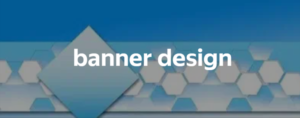Introduction:
In the digital landscape, the website banner is the first visual encounter users have with a brand. A well-designed banner sets the tone, communicates the brand’s identity, and entices visitors to explore further. This blog delves into the art and science of website banner design, exploring key elements, best practices, and how an impactful banner can elevate the overall user experience.

Understanding the Importance of Website Banners:
-
First Impressions Matter:
- Website banners are the digital storefront, creating the crucial first impression. A visually appealing and strategically crafted banner captivates attention and invites users to delve deeper.
-
Brand Identity and Messaging:
- Banners serve as a canvas for brand identity. Consistent color schemes, fonts, and imagery convey the brand’s personality and reinforce key messaging.
-
Promotions and Calls to Action:
- Dynamic banners are powerful tools for showcasing promotions, special offers, or new products. Thoughtful placement of calls-to-action (CTAs) within banners prompts user engagement.
-
Visual Hierarchy:
- Effective banners employ visual hierarchy to guide users through essential information. This includes prioritizing key messages, using contrasting visuals, and leading the eye toward CTAs.
-
Responsive Design:
- With the prevalence of various devices, responsive banner design ensures a seamless user experience across desktops, tablets, and smartphones. Design elements must adapt to different screen sizes without compromising quality.
Designing Striking Website Banners:
-
Clear and Concise Messaging:
- Keep messaging clear and concise. Users should quickly understand the purpose of the banner and the value it offers.
-
Compelling Visuals:
- High-quality, relevant visuals are paramount. Images, illustrations, or graphics should resonate with the brand and evoke the desired emotional response.
-
Legible Typography:
- Choose readable fonts that align with the brand’s identity. Size and contrast matter – ensure text is legible against the background.
-
Consistent Branding Elements:
- Maintain consistency with other branding elements. Use logos, color schemes, and fonts that align with the overall brand identity.
-
Animation and Interactivity:
- Thoughtful animation or interactive elements can enhance engagement. However, balance is crucial; animations should complement the message without overwhelming the user.

